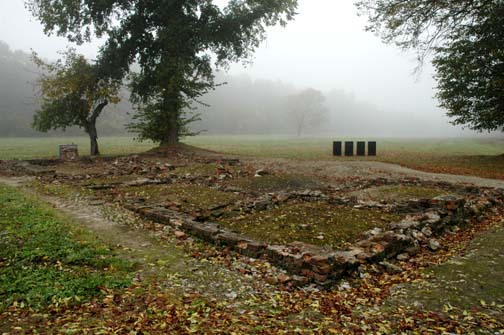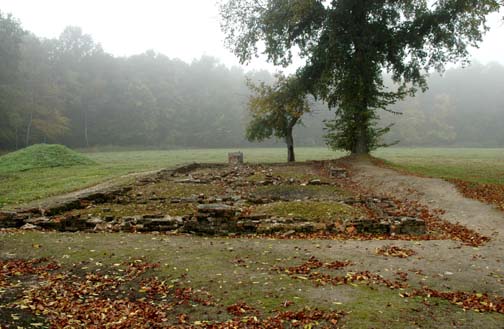Ruins of Bunker 2

The remains of "the
little white house"
Before the construction of the four large
gas chambers at Birkenau was finished in 1943, the gassing of
the Jews took place in two old farmhouses, described as "the
little white house" and "the little red house."
The little red house was located north of where the fourth gas
chamber, called Krema V, was built. It was completely destroyed
by the Nazis and nothing remains of it. The little red house
was the site of the first gassing of the Jews at Birkenau, beginning
in March 1942. The little white house was put into operation
as a gas chamber in June 1942. The two largest gas chambers at
Birkenau were not finished until the spring of 1943.
The little white house was located just
west of the Central Sauna, which was built in 1943 to house a
shower room and numerous disinfection chambers used to kill lice
in the clothing of the prisoners.
The ruins of the little white house have
been preserved, as you can see in the photos on this page. In
the photo above, you can see four black markers which tell visitors
in four languages that this is the ruins of the little white
house, called Bunker 2. The photo below shows a plaque which
also identifies the ruins.

Plaque identifies the
ruins of Bunker 2
After the war, the former Polish residents
of Birkenau came back to rebuild their homes that had been confiscated
by the Nazis and torn down to build the barracks at Birkenau.
They took the bricks from the destroyed gas chambers and used
them to rebuild their houses. The bricks that can be seen today
at the site of Bunker 2 might be a reconstruction, as the valuable
original bricks were probably removed by the Polish residents
sixty years ago.
The photos on this page were taken in
October 2005; when I visited Auschwitz-Birkenau in 1998, my tour
guide told me that the locations of the little white house and
the little red house were unknown.
The ruins show bricks set directly on
the ground, with no foundation, as can be seen in the photo below.

Ruins of the little
white house

The little white house
was divided into four small rooms
As the four photos above show, Bunker
2 was divided into four small rooms which had the capacity to
kill 1,200 Jews at a time, according to Laurence Rees, the author
of "Auschwitz, a New History." Gassing was done with
Zyklon-B, a powerful poison gas also used at Birkenau to kill
lice in the clothing of the prisoners in an attempt to stop the
spread of typhus. Zyklon-B was in the form of pellets, the size
of small peas. The pellets were dropped into the rooms through
an opening in the wall.
According to a book entitled "The
Bombing of Auschwitz: Should the Allies Have Attempted It?"
by Michael J. Neufeld and Michael Berenbaum, Bunker 2 was 56
feet long and 27 feet wide. Each of the four gas chamber rooms
was 14 feet by 7 feet. Bunker 1 was 49 feet long by 21 feet wide.
Survivors say that the four small gas
chambers in the little white house were disguised as shower rooms.
This house was in a remote location and probably did not have
running water, so the victims were not fooled by this ruse. The
ruins of Bunker 2 do not show any signs of plumbing pipes or
a floor drain connected to sewer pipes.
Otto Pressburger, a survivor of Birkenau,
said that the gassings always took place at night, never during
the day time, because the victims would scream or try to escape
from the gas chamber. As quoted by Laurence Rees, Pressburger
said, "We only saw the bodies the next morning piled beside
the pits." Pressburger worked in a special unit of prisoners
whose job it was to bury the bodies of the victims who had been
gassed in the little white house and the little red house. He
said that the SS men brought the bodies to the burial pits during
the night and the next morning, his special unit had to bury
them.
Oscar Groening, an SS man who worked
at Birkenau, also said that the gassing of the Jews in the two
farmhouses was done at night. As told by Laurence Rees, Groening
said that he had witnessed a gassing one night after he had been
awakened by an alarm because a number of Jews had escaped as
they were being marched to the gas chamber. He saw the lights
on in one of the farm houses, and seven or eight bodies out in
front of the building. He assumed that these were the escapees
who had been caught and shot.
Groening was "overcome by curiosity,"
according to Rees, and he and his comrades stayed around to watch
what was going on at the farm house. They saw an SS man, wearing
a gas mask, pour Zyklon-B pellets through a hatch in the side
of the cottage wall. They heard screaming for a minute, followed
by silence. Then an SS man went up to the door, and looked through
a peephole to see if all the prisoners were dead.
This remote area was a good location
for the use of Zyklon-B which was dangerous and had the potential
to kill the SS men who had to throw it inside the building. Until
March 1942, the gassing of the Jews was done in Krema I at the
Auschwitz main camp. Krema I was situated between the SS hospital
and the Gestapo building, not a good location for the use of
dangerous poison gas.
In his autobiography, Rudolf Hoess, the
Commandant at Auschwitz-Birkenau, wrote regarding the gassing
in the little white house:
"Hundreds of men and women in
the full bloom of life walked all unsuspecting to their death
in the gas chambers under the blossom-laden fruit trees of the
orchard. This picture of death in the midst of life remains with
me to this day. I looked upon them as enemies of our people.
The reasons behind the Extermination Program seemed to me right."
This page was last updated on February
10, 2008
|